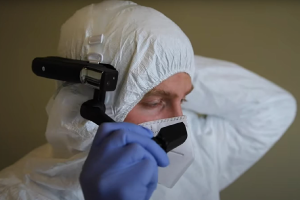Wearable Compute Delivers Healthcare Solutions
In the wake of the novel coronavirus outbreak, the need for social distancing forced a major shift in operations for governments, businesses, schools, and medical facilities. Crisis management, business continuity, and innovation have been propelled to the forefront of every industry. Challenged by the need for production to continue, while minimizing the risk of exposure, the new normal quickly migrated to remote management, oversight, and teleconferencing. While this extreme example has enlightened many doctors, politicians, business leaders and educators alike, the need for disaster planning, resiliency, and resource optimization is nothing new.
Every industry can be impacted by events like hurricanes, fires, civil unrest or even pandemics. For many years, most medical fields have depended on in-person appointments to assess a patient’s condition and provide the right treatment for their recovery. Infection control is a daunting task, relying heavily on resources like personal protection equipment (PPE), strict protocols and, most importantly, medical professionals that are well and able to deliver the critical care needed by so many. Connected worker is a solution that efficiently and effectively connects medical experts to those in need at a large scale to allow those specializing in specific fields to be “present” and able to evaluate a patient, direct the necessary steps for information gathering, treatment and follow-up.

As discussed in our previous blog, How Wearable Technology is Revolutionizing Industrial Operations, Connected Worker delivers a technical solution that empowers those in the field to perform critical and sophisticated tasks with the guidance of a subject matter expert in real-time. This subject matter expertise is delivered through a live connection, both audio and video, to gather and deliver important information, tactical instructions, visual aids and confidence to the worker on site. In the case of COVID-19 response, Connected Worker equips medical professionals with these tools so that one doctor’s expertise can be spread across multiple care facilities, without the need for travel time or the risk of exposure. This offers tangential benefits like a reduction of demand for precious, life-saving PPE. Doctors are able to see what their counterparts see, share images and care instructions with the ability to rapidly exchange information. All without stepping foot on site.
Social Distancing and Its Impact on Healthcare
The need for social distancing is impacting the density of workers in any environment. Reducing their risk of both coming into contact with an infectious individual as well as continuing to spread the infection onsite. It is true that an alarmingly high percentage of hospital and medical facility resources have been held hostage by COVID-19 patients in need of life-saving care. However, the need for other medical services remains. Skilled nursing facilities treating patients with ever-changing, life-threatening wounds are severely impacted by COVID-19’s wrath. Staff limitations, PPE shortages and overall exhaustion of resources lead to dire consequences. Connected Worker equips nursing staff with the eyes, ears and computer monitor of those trained to assess a patient’s wound, develop the appropriate care plan and deliver the necessary care.
Not only can Connected Worker assist those in the infected zones of a healthcare facility with a lessened risk of cross-contamination, but it can also enable the clear zones to continue performing the care and support for patients in need. According to Pluto, “necessity is the mother of invention.” If Connected Worker can deliver drastically impactful efficiencies when needed most, how can Connected Worker improve the medical industry in normal times? Specialized medicine can be difficult to obtain in even the most developed countries, let alone on a global scale. What potential lies in the ability to extend these rare and uniquely qualified experts to under-served regions and populations? How many more lives can be saved or forever changed as a result of a single doctor’s ability to connect with patients anywhere?
How does it work?
Simply put, the medical professionals who are treating patients wear a headset that includes a screen, a camera, and teleconference capabilities. What the wearer sees, their camera displays for others connected on the teleconference (entry-level packages accommodate up to 10 users simultaneously and can be scaled as needed). Similarly, the screen can be shared and annotated by colleagues to take notes, display important visuals, and draw the wearer’s attention to key information. The cameras can even be equipped with infrared thermography to detect elevated body temperatures of others without any physical contact by the wearer. The Connected Worker can be leveraged to provide training for those onsite as well as those observing through the teleconference. In addition, these headsets are specifically designed to be treated with sterilizing agents for use in healthcare environments.
Studies show that between 5-10% of patients contract infections while receiving care in hospital environments. These are known as healthcare-associated or nosocomial infections. Every year, approximately 2 million patients suffer from these infections in the USA, costing 90,000 of them their lives, and hospitals in the range of $28-$45 Billion. How can the practice of telemedicine reduce these numbers while improving the quality of care for patients?
As the initial response to COVID-19 continues to unfold and the medical industry recovers from the flood of related emergencies, thinking shifts towards lessons learned, preparation for the future and applying new technology and techniques, forever changing the status quo of medicine. Connected Worker is a highly adaptable, customizable and scalable solution that can be leveraged in times of trouble and times of calm. To learn more, simply schedule an appointment with our team.

